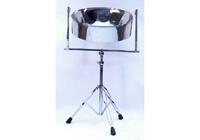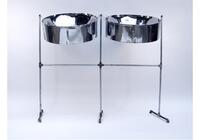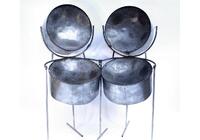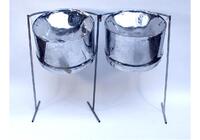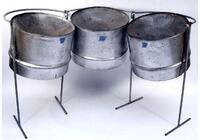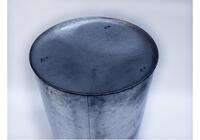Steel Band
Title
Description
Time Period
20th century – present
Physical Description
The steel pan (or steel drum) is composed of from one to nine 55-gallon steel barrel drums, suspended with stands. The bottom end of the barrel is open, with its skirt (or sides) cut from 6 inches to full length for bass instruments. The top end of the barrel is sunk into a concave shape with notes raised upward by a process of firing, cooling and hammering to generate the base pitch and its overtones. The lower the instrument, the shallower the pan is sunk. Notes are delineated by grooving of various shapes, either circular, “U” or squared.
While there is some standardization of note arrangement (for example, the tenor steel pan is arranged in a circle of fifths) there is still much variety, dependent upon the individual maker. On each side of the drum, a hole is drilled to suspend it on metal stands with either nylon/ leather straps or aluminum hooks. Earlier steel pans were suspended around the performer’s neck with a strap, one drum at a time, so that each performer may play only part of an instrument. Today, this form is considered a subgroup style called “pan round the neck.” The steel pan’s primary accompaniment is the “engine room” composed of car brake iron, shaker (“shak-shak”), scraper (guiro), congas, and drum set.
History
The steel pan originated in Trinidad during the late 1930s as an accompaniment to the Carnival masquerade bands. It was a replacement for the tamboo bamboo (stamping tube) ensembles that were outlawed by British colonial law in 1884. In its crude form as biscuit drums and metal tins, the steel pan performed the popular percussive “call and response” style of the tamboo bamboo bands. During the 1940s the steel pan transformed from a percussive instrument into a tuned instrument, and its tuning procedures were established. The tuner would sink the pan with a hammer, then groove the note layout on the concave face, temper the drum over a fire, and fine-tune the notes. By the 1950s, it developed into a tuned and fully chromatic instrument to perform a wide variety of local (calypso, soca, parang) and international (European orchestral music, Latin dance, and jazz, etc.) musical styles. Today, the steel band orchestra in Trinidad and Tobago’s Carnival performances has approx. 100 players.
Tuning
Instrument ranges and tuning generally mimic those of the Western string orchestra, from tenor (one drum) to bass (six to nine drums) and each instrument usually covers two and a half chromatic octaves. While there is some standardization of note arrangement (for example, the tenor steel pan is arranged in a circle of fifths) there is still much variety, dependent upon the individual maker. The drums are traditionally shaped by hand, though recent research and technology has devised a mechanical sinking of the drums (called spin sinking) which allows for greater accuracy and consistency in the bowl’s shape. Other innovations include an expansion of instrument range and electronic amplification.
Technique
The steel pan is played with wood or aluminum mallets wrapped with rubber which allows the instrument to resonate. The thickness of the mallet increases with the number of drums and range of instrument. The bass instrument mallets are made with soft rubber sponge balls. Mallet strokes on the pan must quickly move away from the instrument to allow the drum to resonate. In typical play, the higher (or smaller) notes require more force for an equal volume with the lower (and larger) notes. Due to the relatively short length of resonance, sustained pitches are produced by rapid rolls, or alternation of mallets. The brake iron, the steel pan’s main accompaniment, is held in one hand and struck with a metal rod. Together, several brake iron players perform in a “hocketing” fashion to form a steady metronomic accompaniment for the steel pans.
Notation
Music for steel pan is traditionally learned by rote, however, the professionalisation of performers has led to an increased use of Western notation for performance outside of the traditional Carnival context (such as Trinidad’s World Steelband Festival, which features Western orchestral music). Western musicians learning the music typically learn from written transcriptions of Trinidad steel bands or original written compositions.
Context
The steel pan is primarily performed in Carnival festivals throughout the West Indies and the Caribbean diaspora (New York, Toronto and Nottingham England being the most prominent). Of these, Trinidad’s Panorama Steel Band Competition is the largest and most significant. Expansions of the styles of performance and institutionalization of the bands have allowed other festivals to form, such as Trinidad’s World Steelband Festival for the performance of European orchestral music and the Pan Ramajay festival for jazz. Other contexts derive from the steel pan’s earlier technique of suspending the pan around the performer’s neck with a strap, one drum at a time, so that each performer may play only part of an instrument. Today, this form is considered a subgroup style called “pan round the neck” which generates its own competitions and audience during Carnival.
References
Blake, F.I.R. The Trinidad & Tobago Steel Pan: History and Evolution. Port of Spain, Trinidad: Published by author.
Goddard, George “Sonny.” 1991. Forty Years in the Steelbands, 1939-1979. Port of Spain, Karia Press.
Steumpfle, Stephen. 1995. The Steelband Movement: The Forging of a National Art in Trinidad and Tobago. Philadelphia: Univ. of Pennsylvania Press.
Thomas, Jeffrey Todd. 1985. A History of Pan and the Evolution of the Steel Band in Trinidad and Tobago. M.A. Thesis. Middletown, CT: Wesleyan University.
